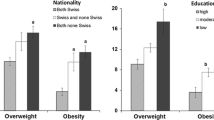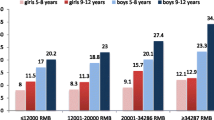Summary
Background
Austria faces increasing numbers of childhood overweight and obesity. Despite increasing numbers of studies, associations between parental body mass index (BMI) and education and the school type on overweight/obesity in students have not been reported. The objective of this study was to evaluate the influence of these parameters on the genesis of overweight/obesity in a large cohort representative of youth in Upper Austrian.
Methods
A cross-sectional analysis of data from 2930 children and adolescents aged 10, 14 or 17 years from 11 different state school types was conducted. Students and their parents completed a questionnaire and heights and weights were measured.
Results
Of the students 16.9% fulfilled the criteria for overweight and 5.6% for obesity, with the highest rates in the 10-year-olds (19.6% and 5.8%, respectively). While no gender differences were present in the youngest age group, the body mass index (BMI) during adolescence remained higher in boys but decreased significantly in girls. Male gender remained a risk factor through all calculations. Boys were overrepresented in schools with lower education levels and more often had BMIs ≥ 85th and ≥95th percentile. Higher parental education levels and lower parental BMIs were associated with lower BMIs of their offspring. Migration was an additional association factor for BMIs ≥ 85th percentile.
Conclusion
Low parental education levels, higher parental BMIs and migration background were associated with overweight and obesity in 10-year-olds. In adolescence, male gender and higher parental BMIs remained risk factors.
Similar content being viewed by others
References
Wang Y, Lobstein T. Worldwide trends in childhood overweight and obesity. Int J Pediatr Obes. 2006;1(1):11–25.
Felder-Puig R, Ramelow D, Hofmann F, Teutsch F, Maier G. Gesundheit und Gesundheitsverhalten von österreichischen Schülerinnen und Schülern: Ergebnisse des WHO-HBSC-Survey 2014. http://www.bmgf.gv.at/cms/home/attachments/9/7/0/CH1444/CMS1427118828092/gesundheit_und_gesundheitsverhalten_oester_schuelerinnen_who-hbsc-survey_2014.pdf. Accessed 1 Dec 2016, Wien: Bundesministerium für Gesundheit.
Elmadfa I. (editor) Österreichischer Ernährungsbericht. Wien: Bundesministerium für Gesundheit; 2012. http://www.bmgf.gv.at/cms/home/attachments/4/5/3/CH1048/CMS1348749794860/oeb12.pdf. Zugegriffen: 3 Mar 2017.
Aeberli I, Ammann RS, Knabenhans M, Molinari L, Zimmermann MB. A decrease in the prevalence of paediatric adiposity in Switzerland from 2002 to 2007. Public Health Nutr. 2009;13(6):806–11.
Sjoberg A, Lissner L, Albertsson-Wikland K, Marild S. Recent anthropometric trends among Swedish school children: evidence for decreasing prevalence of overweight in girls. Acta Paediatr. 2008;97(1):118–23.
Olds T, Maher C, Zumin S, et al. Evidence that the prevalence of childhood overweight is plateauing: data from nine countries. Int J Pediatr Obes. 2011;6(5–6):342–60.
Skinner A, Skelton JA. Prevalence and trends in obesity and severe obesity among children in the United States, 1999–2012. JAMA Pediatr. 2014;168(6):561–6.
Olaya B, Moneta MV, Pez O, et al. Country-level and individual correlates of overweight and obesity among primary school children: a cross-sectional study in seven European countries. BMC Public Health. 2015;15:475–86.
Sweeting HN. Gendered dimensions of obesity in childhood and adolescence. Nutr J. 2008;7:1. doi:10.1186/1475-2891-7-1.
Lobstein T, Frelut M. Prevalence of overweight among children in Europe. Obes Rev. 2003;4(4):195–200.
Lundeen EA, Norris SA, Adair LS, Richter LM, Stein AD. Sex differences in obesity incidence: 20-year prospective cohort in South Africa. Pediatr Obes. 2016;11(1):75–80.
Ogden CL, Carroll MD, Kit BK, Flegal KM. Prevalence of obesity and trends in body mass index among US children and adolescents, 1999–2010. JAMA. 2012;307(5):483–90.
Lobstein T, Baur LA, Uauy R. Obesity in children and young people: a crisis in public health. Obes Rev. 2004;5(Suppl 1):4–85.
Matthiessen J, Stockmarr A, Biltoft-Jensen A, Fagt S, Zhang H, Groth MV. Trends in overweight and obesity in Danish children and adolescents: 2000–2008 – exploring changes according to parental education. Scand J Public Health. 2014;42(4):385–92.
Van Vliet JS, Gustafsson PA, Duchen K, Nelson N. Social inequality and age-specific gender differences in overweight and perception of overweight among Swedish children and adolescents: a cross-sectional study. BMC Public Health. 2015;15:628.
Li J, Hooker NH. Children obesity and schools: evidence from the national survey of children’s health. J Sch Health. 2010;80(2):96–103.
Springer AE, Ranjit N, Delk J, Mehta K, Kelder SH. School-level economic disadvantage and obesity in middle school children in central Texas, USA; a cross.sectional study. Int J Behav Nutr Phys Act. 2015;12(Suppl 1):1–8.
O’Malley PM, Johnston LD, Delva J, Bachman JG, Schulenberg JE. Variation in obesity among American secondary school students by school and school characteristics. Am J Prev Med. 2007;33(4 Suppl):187–94.
Murer SB, Saarsalu S, Zimmermann J, Herter-Aeberli I. Risk factors for overweight and obesity in Swiss primary school children: results from a representative national survey. Eur J Nutr. 2016;55(2):621–9.
Beharat Pour M, Bergström A, Bottai M, et al. Effect of parental migration background on childhood nutrition, physical activity, and body mass index. J Obes. 2014; doi:10.1155/2014/406529.
Segna D, Widhalm H, Pandey MP, Zehetmayer S, Dietrich S, Widhalm K. Impact of mother tongue and gender on overweight, obesity and extreme obesity in 24,989 Viennese children/adolescents (2–16 years). Wien Klin Wochenschr. 2012;124(21–22):782–8.
Visscher PM, Brown MA, McCarthy MI, Yang J. Five years of GWAS discovery. Am J Hum Genet. 2012;90(1):7–24.
Wardle J. Understanding the aetiology of childhood obesity: implications for treatment. Proc Nutr Soc. 2005;64(1):73–9.
Trost SG, Kerr LM, Ward DS. Physical activity and determinants of physical activity in obesity. Int J Obes Relat Metab Disord. 2001;25(6):822–9.
Xu L, Dubois L, Burnier D, Girard M, Prud’homme D. Parental overweight/obesity, social factors, and child overweight/obesity at 7 years of age. Pediatr Int. 2011;53(6):826–31.
Mayer M, Gleiss A, Häusler G, et al. Weight and body mass index (BMI): current data for Austrian boys and girls aged 4 to under 19 years. Ann Hum Biol. 2015;42(1):45–55.
Cole TJ, Bellizzi MC, Flegal KM, Dietz WH. Establishing a standard definition for child overweight and obesity worldwide: international survey. BMJ. 2000;320(7244):1240–3.
Sjoeberg A, Moraeus L, Yngve A, Poortvliet E, Al-Ansari U, Lissner L. Overweight and obesity in a representative sample of schoolchildren – exploring the urban-rural gradient in Sweden. Obes Rev. 2011;12(5):305–14.
Paseka A, Wroblewski A. Eurydice study: gender differences in educational outcomes: a study on the measures taken and the current situation in Europe: report on Austria 2000. http://eacea.ec.europa.eu/education/. Accessed 1 Dec 2016.
Wroblewski A, Herzog-Punzenberger B. OECD thematic review on migrant education. Country background report AUSTRIA 2009. http://www.oecd.org/dataoecd/8/26/42485003.pdf. Accessed 1 Dec 2016.
Acknowledgements
We thank the students from the University of Applied Sciences for collecting the data and the schools and families for their participation. We thank Mrs. Megan Bittermann for language editing of the manuscript. The study was supported by a grant from the Upper Austrian Government.
Author information
Authors and Affiliations
Corresponding author
Ethics declarations
Conflict of interest
D. Furthner, M. Ehrenmüller, A. Biebl, R. Lanzersdorfer, G. Halmerbauer, L. Auer-Hackenberg, and K. Schmitt declare that they have no competing interests.
Caption Electronic Supplementary Material
508_2017_1247_MOESM1_ESM.docx
S1: Results of the regression models: Odds ratios and confidence intervals for all age groups. S2: Overweight and obesity in Austria
Rights and permissions
About this article
Cite this article
Furthner, D., Ehrenmüller, M., Biebl, A. et al. Gender differences and the role of parental education, school types and migration on the body mass index of 2930 Austrian school children. Wien Klin Wochenschr 129, 786–792 (2017). https://doi.org/10.1007/s00508-017-1247-2
Received:
Accepted:
Published:
Issue Date:
DOI: https://doi.org/10.1007/s00508-017-1247-2




